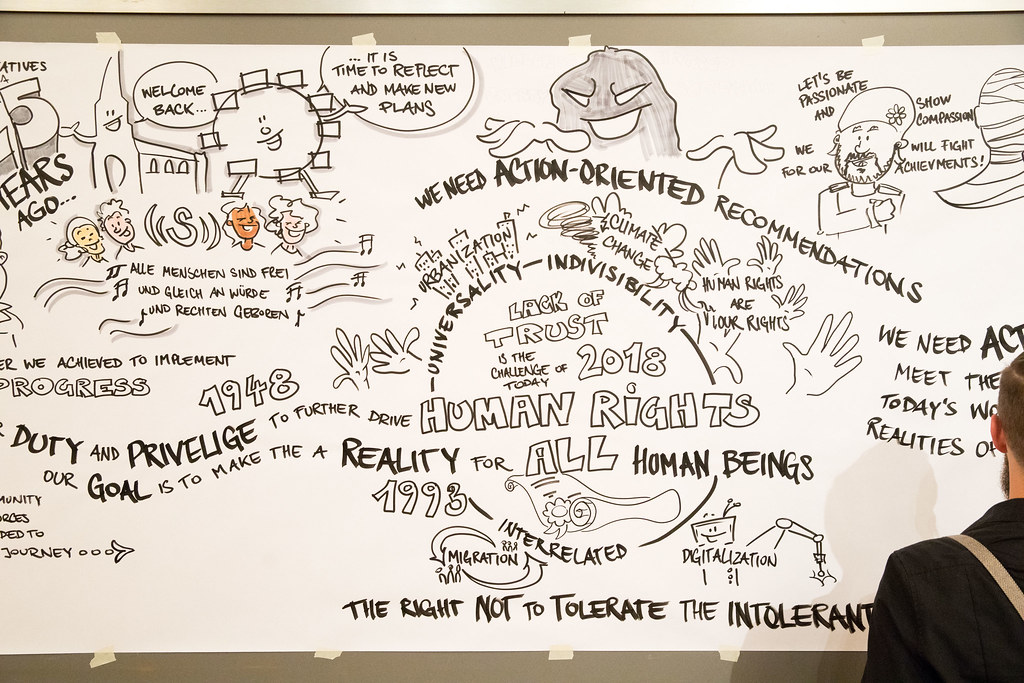Interaktives Material (Komplette Einheit - Schülermaterial)
| Website: | Moodle, virtuelles Arbeiten und eLearning - Herzlich willkommen! |
| Kurs: | Blog Entries: Human Rights & Peacekeeping (11-13) |
| Buch: | Interaktives Material (Komplette Einheit - Schülermaterial) |
| Gedruckt von: | Guest user |
| Datum: | Samstag, 17. Januar 2026, 02:08 |
1. How to write a blog entry: first steps

(C) Christian Schnettelker: https://www.manoftaste.de (https://www.flickr.com/photos/96913861@N04/14045819341)
Step 1:
Use the websites (p.2) to find out more about human right violations and take notes.
Step 2:
Have a look at these blog entries again and make a list with DOs and DON'Ts (p.3).
2. Finding out more about human rights
topics and links |
facts |
|
(1) Ending child poverty is a policy choice https://www.unicef.org/blog/ending-child-poverty-is-policy-choice |
|
|
(2) On Peace, Justice & Structural Violence https://cpcs.wp.st-andrews.ac.uk/people/student-reflective-blogs/ |
|
|
(3) Black Lives Matter – Being an Ally https://blog.westminster.ac.uk/international/black-lives-matter-beinganally/ |
|
|
(4) BLM – A movement or a moment? https://blog.bham.ac.uk/business-school/2020/09/04/black-lives-matter-a-movement-or-a-moment |
|
|
(5) Changing the world |
|
|
(6) On the Engender (#MeToo) https://www.engender.org.uk/news/blog/guest-blog-metoo-just-how-tedious-can-it-get/ |
|
Auf dieser Seite wird Software / werden Dienste / Videos vorgestellt, bei denen Daten auf externen Servern verarbeitet werden können. Die Nutzung ist für Sie freiwillig. Bei der Verwendung von Daten Dritter sind die rechtlichen Rahmenbedingungen zu beachten.
3. How to write a blog entry:

(C) korny.brot (https://www.flickr.com/photos/12348711@N02/1397015149)
4. DOs and DON'Ts:

Human Rights by Nick Youngson CC BY-SA 3.0 Pix4free.org (C) by Nick Youngson: http://www.nyphotographic.com/ & https://pix4free.org/ (https://www.thebluediamondgallery.com/notepad01/h/human-rights.html)
Topics:
- Culture, different generations, education, entertainment, environment, fashion, food, growing up, hobbies, music, news, parents, politics, religion, sports, stereotypes, study, travel,…
- Different purposes: e.g. informing, complaining, persuading your followers, sharing experiences, …
Structure:
Title:
- Catchy“ title to attract the readers’ interest (for example numbers: “four ways to…“; “The ten most important reasons for…“ or provocative questions: “Do you really believe in…?“)
- Your name, the publishing date.
Introduction:
- Try to attract the readers’ interest, for example with an intriguing opening sentence, an initial paradox, a controversy, an anecdote, an amusing story, provocative questions, …
- Make clear why your issue is important, focusing on the purpose your blog entry should serve.
Main body:
- It should capture and maintain the readers’ interests.
- It should contain a clear position and perspective and be supported by credible evidence:It should contain complete thoughts which the reader can follow easily.
- Give well-founded arguments and convincing reasons.
- Give examples and refer to important facts to back up your arguments.
- Refer to counterarguments and show that you can refute them.
- Make sure you convey your opinion in a convincing way.
- The text should be structured and divided into clear paragraphs with an organized logic (between paragraphs and within paragraphs)
Conclusion, salutation and CTA (call to action)
- Sum up your position and your main arguments. Do not, however, use the same phrases again.
- You can also give an outlook for the future, call your readers to action, or invite them to comment on your ideas, for example: Follow me. // Sign up. // Subscribe. // Learn more. // Join us. //…; I‘d be quite interested in your opinion on the issue, post your comment!
Language:
- Formal, semi-formal or informal, depending on the purpose and audience.
- The tone (humoristic, sarcastic, etc.) depends on your audience and purpose.
- In informal blog entries use the first person to address your readers personally.
- Write clear sentences. Use linking words, but be careful with lengthy sentences:
- Unlike German, English tends to use shorter sentences.
- Follow a clear and logical structure and use paragraphs.
- Use vocabulary that is appropriate for your target group and purpose.
- Do not be rude or offensive
- Do not use slang or confusing abbreviations
Sources:
- Bildungsserver Berlin-Brandenburg (2018):
Materialien zum selbstständigen standardorientierten Lernen in der gymnasialen Oberstufe im Fach Englisch – Text production:
- Bildungsserver Hamburg / Bildungsserver Niedersachsen / Uni Leipzig:
Hinweise für Schülerinnen und Schüler sowie Lehrkräfte zur Textsorte blog im schulischen Kontext im Aufgabenteil Sprachmittlung:
http://www.nibis.de/nli1/gohrgs/13_zentralabitur/zentralabitur_2016/20141017MusteraufgabenEN.pdf
- Cornelsen:
Context (2022): S.300ff.
- Hamilton College:
https://www.hamilton.edu/academics/centers/writing/writing-resources/writing-academic-blogs
- Österreichischer Bundesverlag Schulbuch GmbH & Co. KG:
Prime Time 5 + Prime Time 6 (2017): Beiblatt.
5. Human rights digging deeper / blog entry: noticing

(c) photonews.at/Anna Rauchenberger (https://www.flickr.com/photos/minoritenplatz8/28444210778)
Have a quick look at the titles of the following blogs and read the first paragraph to choose one of the topics.
1) Find words and phrases
a) which are useful for talking about your specific topic
b) which you might use for writing your own blog entry later:
examples:
- From my point of view
- XY should be taken into account
- Another issue raised by
- I believe that when it comes to
- you can … and here is how
--> Add them to our vocabulary task cards.
2) Now focus on the content of the blog entry:
Take notes and prepare a short presentation for your classmates.
(1) https://blog.amnestyusa.org/
(2) https://cpcs.wp.st-andrews.ac.uk/people/student-reflective-blogs/
(3) https://world-education-blog.org/category/conflict/
(4) https://www.amnesty.org.uk/blogs
(5) https://www.defendingwomen-defendingrights.org/category/blog/
(6) https://www.humanrightscareers.com/issues/human-rights-blogs/
(7) https://www.sipri.org/commentary/blog
(8) https://www.unicef.org/blog
![]()

Auf Auf dieser Seite wird Software / werden Dienste / Videos vorgestellt, bei denen Daten auf externen Servern verarbeitet werden können. Die Nutzung ist für Sie freiwillig. Bei der Verwendung von Daten Dritter sind die rechtlichen Rahmenbedingungen zu beachten.
6. Writing the first blog entry

(https://pixabay.com/photos/startup-start-up-notebooks-creative-593324/)
To inform more people around the world, we will start our own blog.
For our project website write a blog entry about what could be done against human right violations and assess these measures.
Use the words and phrases (p.5) and have a look at our DOs and DON’Ts list.
7. Feedback

https://pixabay.com/de/photos/r%C3%BCcksendung-feedback-nachricht-1825515/
8. Writing the second blog entry

https://pixabay.com/photos/technology-laptop-keyboard-computer-791029/
You are asked to write another blog entry for our project website.
Watch the some of the following videos about modern day slavery and write this blog entry commenting on the following statement by Desmond Tutu, a South African civil rights activist (1931 – 2021):
"It means a great deal to those who are oppressed to know that they are not alone. Never let anyone tell you that what you are doing is insignificant."
(1) Modern day slavery:
(2) Human trafficking:
(3) Congo: cobalt mines:
(4) Child labour India:
(5) Clothing factory Bangladesh:
(6) Child soldiers:
(7) Domestic staff in Britain:
Original sources:
(1) The Guardian: https://www.theguardian.com/global-development/video/2017/jul/31/why-are-millions-of-people-still-trapped-in-slavery-video
(3) SkyNews: https://news.sky.com/story/meet-dorsen-8-who-mines-cobalt-to-make-your-smartphone-work-10784120
(4) CBS News: https://www.cbsnews.com/news/cbs-news-goes-undercover-in-a-bangladesh-clothing-factory/
(6) TRT News: https://www.trtworld.com/video/rendezvous/the-harsh-reality-of-child-soldiers/5a96b1f0589d8247e2146e4b
(7) The Guardian: https://www.theguardian.com/global-development/video/2016/jan/11/i-was-just-a-slave-the-foreign-domestic-staff-living-a-life-of-five-star-serfdom-in-london-video
Auf dieser Seite wird Software / werden Dienste / Videos vorgestellt, bei denen Daten auf externen Servern verarbeitet werden können. Die Nutzung ist für Sie freiwillig. Bei der Verwendung von Daten Dritter sind die rechtlichen Rahmenbedingungen zu beachten.
9. Feedback

https://pixabay.com/de/photos/r%C3%BCcksendung-feedback-nachricht-1825515/
10. Our own blog

Human Rights by Nick Youngson CC BY-SA 3.0 Alpha Stock Images (http://www.nyphotographic.com) (https://www.thebluediamondgallery.com/typewriter/images/human-rights.jpg)
Let's start our own blog to inform more people about human right violations.
You can publish the blog entries you have already written or get inspired here:
- https://blog.amnestyusa.org/
- https://blogs.worldbank.org/search%3Ff%5B0%5D%3Dlanguage%3Aen%26f%5B1%5D%3Dtopic%3A292
- https://cpcs.wp.st-andrews.ac.uk/people/student-reflective-blogs/
- https://cpj.org/features-and-analysis/
- https://fundamentalrightsforum.eu/
- https://globalvoices.org/
- https://intentionaltravelers.com/blogging-peace-corps/
- https://unpeacekeeping.medium.com/
- https://vinciworks.com/blog/modern-slavery-whats-happening-around-the-world/
- https://world-education-blog.org/category/conflict/
- https://www.amnesty.org/en/latest/
- https://www.amnesty.org.uk/blogs
- https://www.antislavery.org/category/blog/
- https://www.cjr.org/opinion/metoo-academia-sexual-assault-harassment.php
- https://www.defendingwomen-defendingrights.org/category/blog/
- https://www.greenpeace.org/usa/blog/
- https://www.humanrightscareers.com/issues/human-rights-blogs/
- https://savetheact.uk/the-human-rights-act-still-on-high-alert/
- https://www.sipri.org/commentary/blog
- https://www.unicef.org/blog
For example on one of these websites or the school homepage:
- https://de.wordpress.org/
- https://www.blogger.com
- https://substack.com/
- https://tumblr.com
- https://www.webnode.com
Auf dieser Seite wird Software / werden Dienste / Videos vorgestellt, bei denen Daten auf externen Servern verarbeitet werden können. Die Nutzung ist für Sie freiwillig. Bei der Verwendung von Daten Dritter sind die rechtlichen Rahmenbedingungen zu beachten.